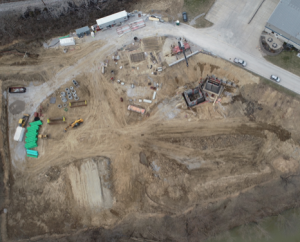Sanitation District No. 1 is building an equalization (EQ) tank and wet weather pump station along the Licking River in Wilder to begin a three-phase project to eliminate more than 47 million gallons of sanitary sewer overflows (SSO).
The Licking River Siphon is the largest SSO location in Northern Kentucky, representing about 41 percent of all reoccurring SSOs that SD1 must eliminate by the year 2040 to meet the terms of its Clean H2O40 amended consent decree with the Commonwealth of Kentucky and the US Environmental Protection Agency.
Controlling such a significant source of pollution requires a multi-phase approach. This first project will eliminate about 5 million gallons of SSOs by installing a 7.3-million-gallon tank and a wet-weather pump station while also upsizing approximately 1,800 feet of sanitary sewer from Route 9 to the tank location.

Work in progress on Licking River Siphon Project.
Later, SD1 plans to install a second siphon underneath the river and upsize the conveyance system downstream to eliminate the remaining typical-year SSO volume.
“The sanitary sewers in this area experience excessive inflow and infiltration during heavy rainfall, resulting in sewer overflows,” said SD1 Project Manager Lydia Watkins.
She said the tank, which is the third planned tank in Northern Kentucky, joining tanks currently under construction in Highland Heights and Silver Grove, will operate during rain events, allowing SD1 to store wastewater that would otherwise overflow into the creek and river.
The tank’s size and location also allow SD1 to control how and when wastewater flows are reintroduced into the sewer system, reducing the need for a larger siphon now and in the future.
“The Licking River Siphon project is part of SD1’s controlled storage approach to managing sewer overflows,” said SD1 Executive Director Adam Chaney. “This strategy, paired with targeted upsizing of pipes, is the most cost-effective strategy to accomplish our Clean H2O40 goals. These projects will help improve our community’s quality of life by eliminating a significant source of water pollution.”
This first phase of the project, expected to cost about $13 million, will be under construction through July 2022.
Sanitation District #1
















